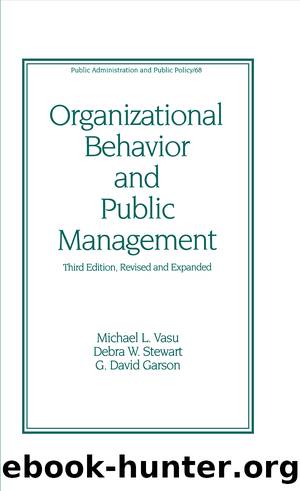Organizational Behavior and Public Management by unknow

Author:unknow
Language: eng
Format: epub
Tags: Government & Business, Public Affairs & Administration, Political Science, Business & Economics, General
ISBN: 9780824701352
Google: T7iEAQAACAAJ
Goodreads: 1300184
Publisher: Routledge
Published: 1990-01-19T00:00:00+00:00
Planning and Rational Models of Decision-Making
When students think of decision-making, they often assume a rational model; that is, a model in which there is a clear relationship between ends and means. This model takes on a number of forms the essential features are: (1) Identify objectives; (2) identify alternative courses of action for achieving those objectives; (3) predict and evaluate the possible consequences of each alternative; and (4) select the alternative that maximizes the attainment of the objectives. This so called ârational decision-making modelâ always begins with a statement of the goals or objectives to be achieved. Obstacles to the achievement of objectives are inventoried. For each obstacle, alternative solutions are surveyed and the optimal one is selected. Solutions are spelled out into task matrices which relate resources (personnel, materials) to these tasks. Tasks are assembled into a rational, sequential plan through a process, like program evaluation and review techniques (PERT) or other planning processes. Later, costs and benefits are tracked through program budgeting as a database for evaluation and possible revision of the plan selected.
This vision of ârational planningâ was at its peak in the United States in the 1930s and 1940s. A symbol of this vision was the National Resources Planning Board, directed by Charles Merriam, a leading political scientist of the 1930s. Political scientists of that era had begun to condemn the âramshackle character of our national legislative machine,â as Edwin Corwin put it in his 1931 presidential address to the American Political Science Association (APSA) (Corwin, 1932). Corwin called on political scientists to put aside questions of power and influence and instead concentrate on issues of management and planning.
This orientation was epitomized the following year when Henry Dennison, an industrialist, was invited to present his view to the APSA on âThe Need for the Development of Political Science Engineeringâ (Dennison, 1932). Related groups such as the Brookings Institution pointed toward the planning models of the French and German advisory economic councils (Lorwin, 1931). By 1934, a vast amount of American literature on social planning was available (see Brooks and Brooks, 1933, 1934), ranging from Chamber of Commerce reports to Harry Laidlerâs Socialist Planning and a Socialist Program (1932). George E. G. Catlin wrote, âThe blessed word Mesopotamia of the last decade was ârationalizationâ; of this decade, it is planningâ (Catlin, 1932).
In a decade, social planning emerged from a concept bordering on sedition to one accepted by nearly all segments of American society. There was a relative consensus in the planning literature on the general vision of using state power to achieve regulation, security, and fairness. Typical was Rexford Tugwellâs Industrial Discipline and the Governmental Arts (1933). Tugwell, a close advisor of President Roosevelt, argued that the alternative to class conflict in the Depression was a cooperative effort of social planning and regulation of the economy. Social planning themes were predominant in such New Deal innovations as the Blue Eagle (NRA) code authorities and the Tennessee Valley Authority (TVA). Indeed, the vision of national social planning through
Download
This site does not store any files on its server. We only index and link to content provided by other sites. Please contact the content providers to delete copyright contents if any and email us, we'll remove relevant links or contents immediately.
How Leaders Decide by Khanduja Harjeet;(152)
Project Management for Dummies by Stanley E. Portny & Jonathan L. Portny(107)
101 Ways to Save Money on Your Tax--Legally! 2022-2023 by Adrian Raftery(92)
Understanding Strategic Management by Anthony Henry(68)
Organizational Behavior and Public Management by unknow(63)
The Prepared Mind of a Leader by Bill Welter(51)
International trade and development theory by ronald Findlay(50)
J by Admin(48)
Development and Application of a Complete Active Space SpinâOrbit Configuration Interaction Program Designed for Single Molecule Magnets by Unknown(47)
Back Cover: Industrial RuO2Based Deacon Catalysts: Carrier Stabilization and Active Phase Content Optimization (ChemCatChem 32013) by Unknown(46)
Who Says? by Joe Mechlinski(45)
Knowledge and Class a Marxian Critique of Political Economy by Unknown(40)
BUSN10 Introduction to Business-South-Western College Pub (2017) by Unknown(40)
Public Health in India: Policy Shifts and Trends by P. M. Arathi (editor)(28)
On the Accuracy of Economic Observations by Oskar Morgenstern(27)
STRATEGIC by FREDERICK BETZ(16)
